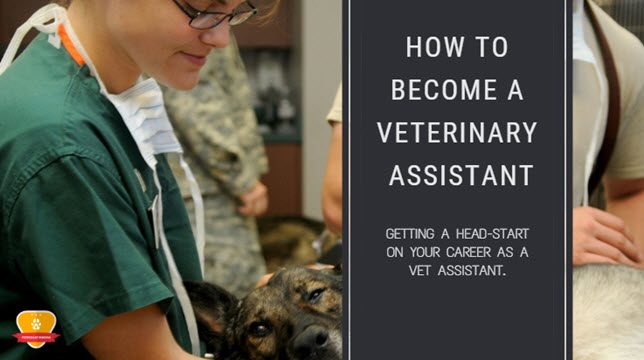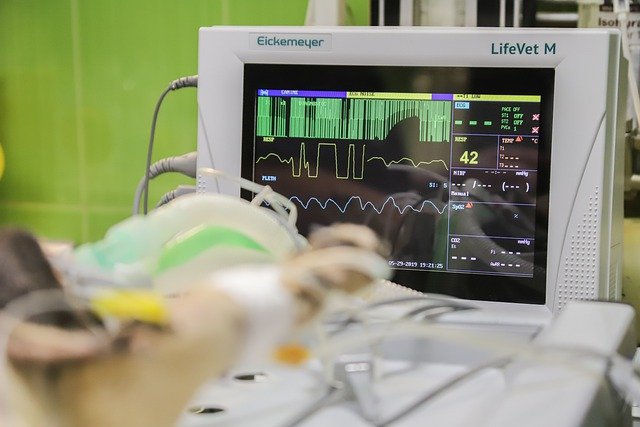If you’re thinking about becoming a veterinary assistant, then this page will be helpful to you.
As a vet assistant, you will do many tasks before the veterinarian sees the animal.
For instance, administer the prescribed medications.
There are other duties you will be responsible for as well.
Read on to find out more about this profession.
- Job Description
- Salary
- How to Become
- Education
- Certification & Licensing
- Popular Programs
- Job Outlook
- Should You Become
- FAQs
- Info by State
- Similar Careers
What Does a Veterinary Assistant Do?
A vet assistant has a very important role for both animal patients and their owners.
And at its most basic, your job is to take care of the animals.
That’s why it’s vital that you be kind and patient to service them effectively.
Let’s take a look at what other duties you’ll shoulder.
Duties
Here’s the extensive list of your duties at the veterinary clinic.
- Clean the animals’ cages
- Administer medication prescribed by the vet
- Feed, water, and walk animals
- Clean and sanitize exam rooms and treatment areas
- Maintain patient charts and keep records up to date
- Properly restrain patients for blood, urine, or tissue samples
- Surgery preparation
- Sterilize surgical equipment
- Perform laboratory tests like x-rays
How Much Does a Veterinary Assistant Earn?
Many people wonder about this.
As of this writing, the national salary for a vet assistant ranges from $23,899 to $35,762 per year.
That’s $29,648 per year on average.
But it’s possible for you to earn more than $35,000 annually.
It depends on several factors, such as:
- Education
- Where you live
- Where you plan to work
In fact, some states are willing to pay you higher simply because of the education you received.
Related read: Comprehensive guide to a veterinary assistant’s salary
Average National Salary: $29,648
Salary Information by State
| State | Employed | Avg. Annual Salary | Avg. Hourly Pay | Top 10% Annual Salary | Bottom 10% Annual Salary |
|---|---|---|---|---|---|
| Alabama | 1,060 | $31,240 | $15.02 | $38,540 | $23,420 |
| Alaska | 150 | $39,950 | $19.21 | $54,820 | $29,390 |
| Arizona | 2,210 | $39,460 | $18.97 | $49,230 | $33,620 |
| Arkansas | 1,200 | $33,340 | $16.03 | $37,490 | $27,000 |
| California | 14,960 | $46,500 | $22.36 | $58,550 | $37,230 |
| Connecticut | 1,270 | $46,350 | $22.28 | $71,200 | $34,480 |
| Delaware | 180 | $37,710 | $18.13 | $47,780 | $30,260 |
| District of Columbia | 150 | $45,340 | $21.80 | $56,730 | $36,260 |
| Florida | 7,060 | $37,460 | $18.01 | $45,650 | $29,350 |
| Georgia | 3,280 | $34,530 | $16.60 | $41,250 | $28,410 |
| Hawaii | 510 | $39,230 | $18.86 | $48,240 | $29,590 |
| Idaho | 790 | $35,460 | $17.05 | $45,970 | $27,070 |
| Illinois | 3,790 | $38,890 | $18.70 | $47,830 | $30,300 |
| Indiana | 2,670 | $34,860 | $16.76 | $43,370 | $28,020 |
| Iowa | 1,040 | $34,410 | $16.54 | $45,320 | $28,930 |
| Kansas | 1,490 | $33,870 | $16.28 | $46,100 | $26,000 |
| Kentucky | 930 | $33,830 | $16.26 | $45,490 | $23,750 |
| Louisiana | 970 | $31,130 | $14.96 | $37,790 | $26,180 |
| Maine | 790 | $46,790 | $22.50 | $58,120 | $37,350 |
| Maryland | 1,690 | $44,880 | $21.58 | $59,860 | $34,680 |
| Massachusetts | 1,470 | $47,460 | $22.82 | $63,650 | $34,740 |
| Michigan | 4,040 | $37,580 | $18.07 | $47,010 | $29,410 |
| Minnesota | 1,220 | $41,880 | $20.13 | $47,260 | $34,060 |
| Mississippi | ** | $30,440 | $14.64 | $35,900 | $23,480 |
| Missouri | 2,040 | $34,890 | $16.77 | $40,670 | $29,250 |
| Montana | 580 | $36,660 | $17.62 | $41,720 | $28,910 |
| Nebraska | 800 | $34,410 | $16.54 | $39,320 | $28,290 |
| Nevada | 1,400 | $37,130 | $17.85 | $47,380 | $30,570 |
| New Hampshire | 560 | $35,930 | $17.27 | $45,140 | $28,180 |
| New Jersey | 1,910 | $44,460 | $21.38 | $57,350 | $35,720 |
| New Mexico | 470 | $35,320 | $16.98 | $44,910 | $28,920 |
| New York | 5,680 | $43,300 | $20.82 | $51,170 | $36,210 |
| North Carolina | 5,190 | $37,510 | $18.04 | $45,810 | $29,920 |
| North Dakota | 240 | $37,400 | $17.98 | $43,230 | $31,210 |
| Ohio | 4,190 | $35,850 | $17.24 | $45,900 | $28,820 |
| Oklahoma | 1,640 | $32,180 | $15.47 | $44,650 | $21,410 |
| Oregon | 2,670 | $42,500 | $20.43 | $48,230 | $35,620 |
| Pennsylvania | 4,390 | $38,070 | $18.30 | $47,010 | $30,390 |
| Rhode Island | 360 | $44,050 | $21.18 | $48,630 | $32,950 |
| South Carolina | 1,840 | $36,240 | $17.42 | $48,430 | $28,280 |
| South Dakota | 270 | $32,290 | $15.52 | $36,670 | $26,950 |
| Tennessee | 2,180 | $36,510 | $17.55 | $44,020 | $29,410 |
| Texas | 8,040 | $33,170 | $15.95 | $46,020 | $22,040 |
| Utah | 720 | $36,980 | $17.78 | $46,710 | $30,570 |
| Vermont | 260 | $36,510 | $17.55 | $45,490 | $30,320 |
| Virginia | 4,880 | $37,410 | $17.99 | $45,800 | $30,400 |
| Washington | 4,720 | $43,230 | $20.78 | $47,680 | $37,540 |
| West Virginia | 660 | $31,720 | $15.25 | $36,990 | $22,770 |
| Wisconsin | 1,940 | $35,010 | $16.83 | $42,800 | $29,160 |
| Wyoming | 160 | $34,360 | $16.52 | $38,020 | $29,380 |
| Puerto Rico | 590 | $22,630 | $10.88 | $27,050 | $19,850 |
Annual Average Salary: Top 10 States
The top earning state in the field is Massachusetts, where the average salary is $47,460.
These are the top 10 earning states in the field:
* Employment conditions in your area may vary.
Step-by-Step Guide to Becoming a Veterinary Assistant
Step 1 Secure Your High School Diploma
Graduating high school means you have the competency to study science classes.
This makes it easier for you to understand veterinary sciences later on.
Step 2 Earn a Certificate
Only 34% of vet assistants do not have a certificate.
This tells you that a certificate may not be mandatory, but it’s useful career-wise.
It makes you more competitive and qualified than non-certified vet assistants.
You can obtain a certificate from the National Association of Veterinary Technicians in America (NAVTA).
Step 3 Apply for an Internship
There are two kinds of internship you can consider:
- Volunteer internship
- Paid internship
Whatever you choose, know that both will give you the same practical experience.
The good thing about an internship is that you can:
- Interact with different animals
- See first-hand how professionals care and treat animals
Step 4 Apply for a Job
Vet assistants are in demand, and there are many places you can apply to.
- Animal shelters
- Veterinary hospitals/clinics
- Zoos
- Local government agencies
Step 5 Advance Your Career
We recommend that you pursue continuing education on top of the NAVTA program.
You can either study for a:
- Two-year associate’s degree
- Four-year bachelor’s degree
Doing so helps you move up and become a veterinary technician.
Find Schools »Education Needed to Become a Veterinary Assistant
At a minimum, you only need a high school education and enroll in a training program.
But many employers prefer someone who has obtained formal education over one without.
Fortunately, Veterinary Assistant (VA) programs are available for high school students.
This gives them the opportunity to earn a VA title and certification.
Here, you’ll learn the preparatory training necessary to become a vet assistant.
You only have to complete the:
- Required lessons, exams, and activities
- Apprenticeship under professional supervision
At the end of it, you’ll have extensive knowledge of the following:
- Common diseases in animals
- Diagnostic processes
- Lab procedures
- Treatment methods
Another option is to enroll in a NAVTA-approved training program.
NAVTA has partnered with several high schools to make its program more accessible.
Aside from that, they also offer the program online and in various colleges.
Important Note
You don’t have to take a VA certification program if you plan to pursue an associate or bachelor’s degree.
And vice versa.
So we advise you to consider seriously whether to take a VA program or a college degree.
Of course, if you want to, you can do both.
This will make you better qualified than others in the job market.
Here’s a video for you to get some insights into this profession.
Video About The Career
Certification and Licensing
A vet assistant doesn’t have to get certified to work as one.
But many places are starting to prefer someone with certification work for them.
One certification employers widely acknowledge is NAVTA’s Approved Veterinary Assistant (AVA).
You’ll have to:
- Enroll and graduate from a NAVTA-approved training program
- Pass the exam
Once you pass, you’ll earn your certificate and formal designation as an AVA.
With this certification, you prove to people that you have the proficiency to be a vet assistant.
NAVTA encourages VA graduates to pursue an education as vet technicians.
Average Training Program Duration: 2-4 Years
Popular Programs
Get your accredited and budget-friendly associate degree or career diploma entirely online!
Veterinary AssistantVeterinary TechnicianVet Office ManagerDog ObediencePet GroomingSponsored Online Programs.Job Outlook and Growth for Veterinary Assistants
This profession will have a growth rate of 14% between 2020 and 2030.
By 2030, the U.S. Bureau of Labor Statistics projected employment to be 122,500.
The reason stems from the increase in pet-related spending.
This drove the increased demand for veterinary services.
Meaning, the more procedures vets perform, the more they need vet assistants to help them.
All in all, employment prospects look great for vet assistants in the next 10 years.
Related read: Comprehensive guide to veterinary assistant jobs
Employment Growth Projection: 19%
2023
2033
That's a higher than average projected growth of 22,900: Interest Over Time
Should You Become a Veterinary Assistant?

Overall Satisfaction: High
Many vet assistants find their job rewarding.
It allows them to help animals and sometimes even save their lives.
What’s more, they feel good to see the happiness in the animal and their owners’ faces.
It’s only then can they say that they’ve done their job well.

Average Salary: High
Vet assistants receive an average range of $23,889 to $35,762.
This salary is already considered good in the industry.
And if you get all relative certifications or degrees, then you’ll be able to earn more.
The same goes for the state you’re currently working in.
After all, it’s been known that some states pay more than others.
You can check out the salary table above for information.

Job Growth Outlook: High
More and more people now are now willing to spend on animal care.
And this positively affected the growth of veterinary services.
And with a 14% expected growth rate, demand for vet assistants will continue to rise in the next 10 years.

Education Duration: 2-4 Years
In terms of education, you have two options.
You can either:
- Enroll in a VA program after high school
- Pursue an associate or bachelor’s degree
At most, it will take two to four years of schooling.

Personal Skills Needed
Not everyone can handle the high demands of this job.
That’s why you need to possess the following:
Love and care for animals
This is rule number one.
Having enough love and care to give to your animal patients makes you more trustworthy to pet owners.
Physically fit
Being in good shape can help you move quickly and complete your tasks on time.
Ability to multitask
You may be working on multiple animals at the same time.
So you should be able to focus and remember which animal has what needs.
Interpersonal skills
You are dealing with several people every day.
Having good people skills can make you interact and communicate with them better.
Stress management
Being a vet assistant is stressful.
Sometimes, you’ll be caught in stressful situations.
You have to be able to handle these situations with poise and grace
Good temperament
Stress can cause mood fluctuations.
So you have to be able to keep your cool and still show a good disposition at all times.
Frequently Asked Questions
Q. What do you do as a veterinary assistant?
There are many duties to be performed as a vet assistant.
To name a few:
- Weigh, feed, exercise animals
- Provide basic care
- Cleaning and sanitizing of equipment
- Administering medication
Q. How many days does a veterinary assistant work?
On average, you will work 25 to 40 hours a week.
That equals 3 to 5 days.
However, emergencies may require you to be on-call at all times.
Q. How much does a veterinary assistant make in an hour?
On average, you can earn $11.75 an hour.
Again, this amount varies depending on:
- Your qualifications
- The state you’re working in
Q. What skills do you need to be a veterinary assistant?
First of all, you need to have knowledge of and experience in animal care.
Other personal skills include:
- Ability to multitask
- Physically fit
- Good stress management
Q. What qualifications do you need to be a veterinary assistant?
At a minimum, you need a:
- High school diploma
- VA training
- Internship
It’s not necessary to get a certification, but it does help you gain a competitive advantage.
Q. How long do you have to go to school to be a veterinary assistant?
Most vet clinics require you to at least get an associate’s degree.
This can take you more or less two years to complete.


